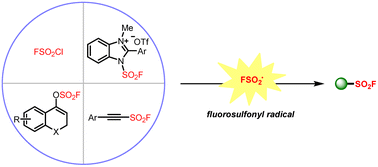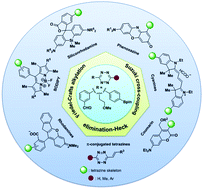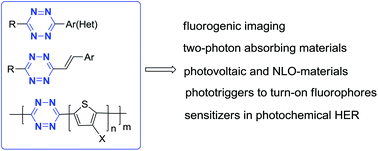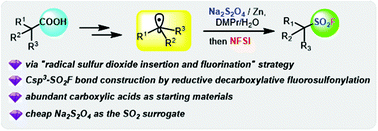Themed collection FOCUS: Recent progress on click chemistry and bioorthogonal chemistry

Fluorosulfonyl radicals: new horizons for the synthesis of sulfonyl fluorides
Recent advances in the generation of fluorosulfonyl radicals toward sulfonyl fluorides are highlighted.

Org. Chem. Front., 2022,9, 5299-5305
https://doi.org/10.1039/D2QO01211A
Derivatization based on tetrazine scaffolds: synthesis of tetrazine derivatives and their biomedical applications
The recent advances in tetrazine scaffold-based derivatizations have been summarized. The advantages and limitations of derivatization methods and applications of the developed tetrazine derivatives in bioorthogonal chemistry have been highlighted.

Org. Chem. Front., 2022,9, 481-498
https://doi.org/10.1039/D1QO01324F
1,2,4,5-Tetrazine derivatives as components and precursors of photo- and electroactive materials
Synthetic approaches to 3,6-disubstituted-1,2,4,5-tetrazine systems are analyzed, and their properties attractive to practical applications in photo- and electroactive materials are overviewed.

Org. Chem. Front., 2021,8, 5182-5205
https://doi.org/10.1039/D1QO00465D
Photocatalytic fluorosulfonylation of aliphatic carboxylic acid NHPI esters
SO2 radical insertion/fluorination via a photocatalytic redox strategy is developed, providing an efficient and reliable approach for the synthesis of alkylsulfonyl fluorides.

Org. Chem. Front., 2022,9, 4854-4860
https://doi.org/10.1039/D2QO00861K
α-Vinyl azide–cysteine click coupling reaction enabled bioorthogonal peptide/protein modification
α-Alkyl and α-aryl vinyl azides were found to be able to couple with cysteine-derived alkyl thiols chemoselectively under mild conditions, providing the corresponding β-ketosulfides with simultaneous extrusion of N2 and ammonia.

Org. Chem. Front., 2022,9, 4654-4662
https://doi.org/10.1039/D2QO00736C
Photocatalytic access to aromatic keto sulfonyl fluorides from vinyl fluorosulfates
A photocatalytic transformation of vinyl fluorosulfates to aromatic β-keto sulfonyl fluorides is developed using 1 mol% of Ir catalyst irradiated by 3 W blue LEDs. This methodology provides an efficient and readily scalable approach to aromatic β-keto sulfonyl fluorides.

Org. Chem. Front., 2022,9, 3540-3545
https://doi.org/10.1039/D2QO00416J
Triazolated calix[4]semitubes: assembling strategies towards long multicalixarene architectures
Triazolated triscalixarene semitubes with different mutual arrangements of two bistriazole sites can be assembled by a four-fold or stepwise CuAAC from calix[4]arenes having two or four 2-azidoethyl or/and propargyl groups in their structures.
![Graphical abstract: Triazolated calix[4]semitubes: assembling strategies towards long multicalixarene architectures](/en/Image/Get?imageInfo.ImageType=GA&imageInfo.ImageIdentifier.ManuscriptID=D2QO00432A&imageInfo.ImageIdentifier.Year=2022)
Org. Chem. Front., 2022,9, 3084-3092
https://doi.org/10.1039/D2QO00432A
Aliphatic sulfonyl fluoride synthesis via reductive decarboxylative fluorosulfonylation of aliphatic carboxylic acid NHPI esters
A general and efficient approach to various aliphatic sulfonyl fluorides by the reductive decarboxylative fluorosulfonylation of aliphatic carboxylic acids via a radical sulfur dioxide insertion and fluorination strategy was developed.

Org. Chem. Front., 2022,9, 1115-1120
https://doi.org/10.1039/D1QO01655E
Taming the reactivity of alkyl azides by intramolecular hydrogen bonding: site-selective conjugation of unhindered diazides
The intramolecular hydrogen bonding in the α-azido secondary acetamides (α-AzSAs) enabled site-selective integration onto the diazide modular hubs even without steric hindrance.

Org. Chem. Front., 2021,8, 5793-5803
https://doi.org/10.1039/D1QO01088C
Prolinamide plays a key role in promoting copper-catalyzed cycloaddition of azides and alkynes in aqueous media via unprecedented metallacycle intermediates
Room temperature copper-catalyzed cycloaddition of azides and alkynes (CuAAC) proceeds in the presence of a prolinamide ligand in aqueous media via unique metallacycles.

Org. Chem. Front., 2021,8, 2434-2441
https://doi.org/10.1039/D0QO01150A
About this collection
This year’s Nobel Prize in Chemistry was awarded to K. Barry Sharpless, Morten Meldal, and Carolyn R. Bertozzi for their development of click chemistry and bioorthogonal chemistry. Click chemistry describes reactions in which molecular building blocks snap together quickly and efficiently, and has found widespread applications in organic synthesis, chemical biology, drug discovery and materials science.
This online collection highlights some exciting research about click chemistry and bioorthogonal chemistry that recently appeared in Organic Chemistry Frontiers. Articles featured in our focus collections are handpicked by Editors. We hope you find them enjoyable to read.